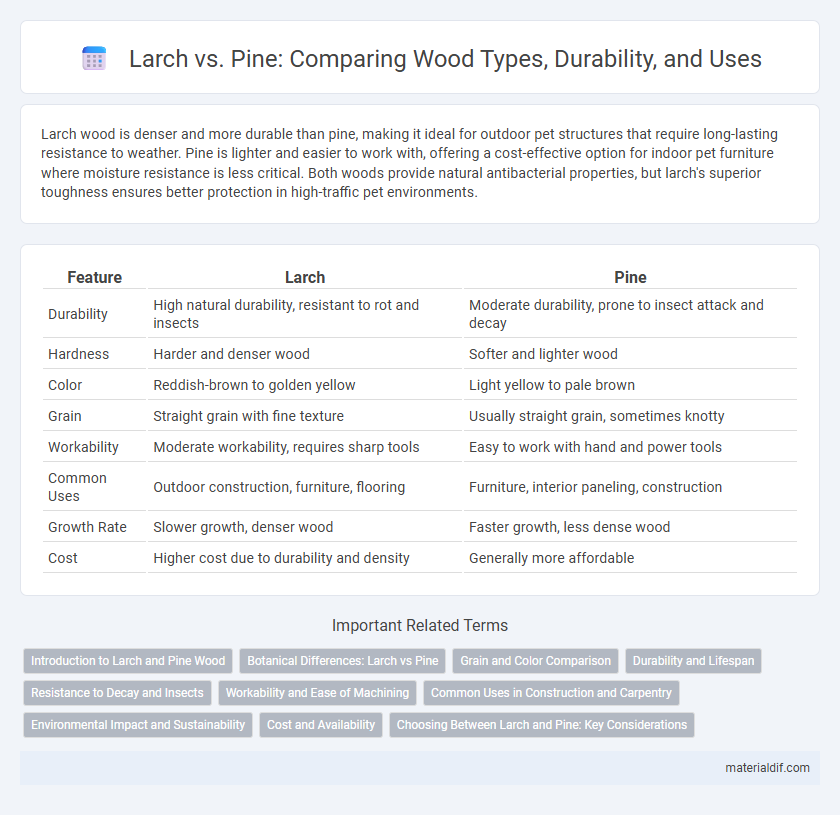Larch wood is denser and more durable than pine, making it ideal for outdoor pet structures that require long-lasting resistance to weather. Pine is lighter and easier to work with, offering a cost-effective option for indoor pet furniture where moisture resistance is less critical. Both woods provide natural antibacterial properties, but larch's superior toughness ensures better protection in high-traffic pet environments.
Table of Comparison
| Feature | Larch | Pine |
|---|---|---|
| Durability | High natural durability, resistant to rot and insects | Moderate durability, prone to insect attack and decay |
| Hardness | Harder and denser wood | Softer and lighter wood |
| Color | Reddish-brown to golden yellow | Light yellow to pale brown |
| Grain | Straight grain with fine texture | Usually straight grain, sometimes knotty |
| Workability | Moderate workability, requires sharp tools | Easy to work with hand and power tools |
| Common Uses | Outdoor construction, furniture, flooring | Furniture, interior paneling, construction |
| Growth Rate | Slower growth, denser wood | Faster growth, less dense wood |
| Cost | Higher cost due to durability and density | Generally more affordable |
Introduction to Larch and Pine Wood
Larch wood is a dense, resinous softwood prized for its durability, natural resistance to decay, and vibrant reddish hue, commonly used in outdoor construction and marine applications. Pine wood, characterized by its light color and softer texture, is widely favored for furniture, paneling, and general construction due to its workability and abundant availability. Both larch and pine belong to the conifer family but differ significantly in hardness, grain structure, and moisture resistance, influencing their specific uses in woodworking and building projects.
Botanical Differences: Larch vs Pine
Larch (genus Larix) and Pine (genus Pinus) differ botanically in needle arrangement and reproductive structures; larch needles are soft, deciduous, and clustered in short shoots, while pine needles are evergreen and grouped in bundles called fascicles. Larch produces small, egg-shaped cones that mature quickly, contrasting with pine cones that vary widely in size and often have a longer maturation period. Both genera are conifers from the family Pinaceae, but larch's unique seasonal needle drop distinguishes it from most pine species, which retain their needles year-round.
Grain and Color Comparison
Larch wood features a distinct, straight grain with occasional wavy patterns, offering a rich golden to reddish-brown color that deepens with age. Pine exhibits a more prominent, lighter grain pattern, often knotty and pale yellow to light brown, which can darken slightly over time. The contrast between larch's tighter grain and deeper hues versus pine's softer, more uniform grain and lighter shade makes them suitable for different aesthetic and structural applications.
Durability and Lifespan
Larch exhibits superior durability compared to pine due to its higher resin content, which enhances resistance to rot and insect damage. The natural longevity of larch typically ranges from 25 to 40 years in outdoor applications, while pine generally lasts around 15 to 20 years unless chemically treated. Selecting larch over pine significantly improves lifespan and reduces maintenance needs in construction and outdoor projects.
Resistance to Decay and Insects
Larch wood exhibits superior resistance to decay and insects due to its high resin content, making it ideal for outdoor construction and marine applications. Pine, while more widely available and easier to work with, is more susceptible to fungal decay and insect attacks without proper treatment. Selecting larch over pine increases durability and longevity in environments prone to moisture and pest exposure.
Workability and Ease of Machining
Larch wood is denser and harder than pine, resulting in greater durability but slightly reduced ease of machining. Pine's softer texture allows for smoother cuts and faster workability with hand or power tools, making it ideal for intricate detailing and projects requiring frequent shaping. Both woods respond well to sanding and finishing, but pine's softness facilitates quicker adjustments and less tool wear during machining processes.
Common Uses in Construction and Carpentry
Larch wood is favored in construction for its high durability and natural resistance to rot, making it ideal for exterior cladding, fencing, and heavy structural elements. Pine, widely used in carpentry, offers ease of workability and affordability, commonly employed in interior framing, furniture, and moldings. Both woods contribute unique strengths; larch excels in outdoor applications while pine remains a versatile choice for interior construction projects.
Environmental Impact and Sustainability
Larch wood is known for its natural durability and resistance to decay, reducing the need for chemical treatments and making it a more eco-friendly option compared to pine. Pine grows faster and stores carbon efficiently, but it often requires more intensive forestry management and chemical preservatives, which can increase its environmental footprint. Choosing larch supports sustainable forestry practices by promoting longer-lasting materials with fewer chemical inputs, contributing to reduced ecological impact.
Cost and Availability
Larch wood tends to be more expensive than pine due to its higher durability and density, making it suitable for outdoor applications where longevity is essential. Pine is more widely available and generally more affordable, favored for interior use and mass production because of its faster growth rate. Availability of larch is often limited to specific regions, whereas pine is harvested globally, affecting the overall cost and accessibility in the market.
Choosing Between Larch and Pine: Key Considerations
Larch wood offers superior durability and natural resistance to decay compared to pine, making it ideal for outdoor projects and heavy-duty applications. Pine, being softer and more affordable, is preferred for interior uses where ease of workability and cost-effectiveness are important. When choosing between larch and pine, factors such as exposure to weather, budget constraints, and desired wood hardness should guide the decision.
Larch vs Pine Infographic

 materialdif.com
materialdif.com